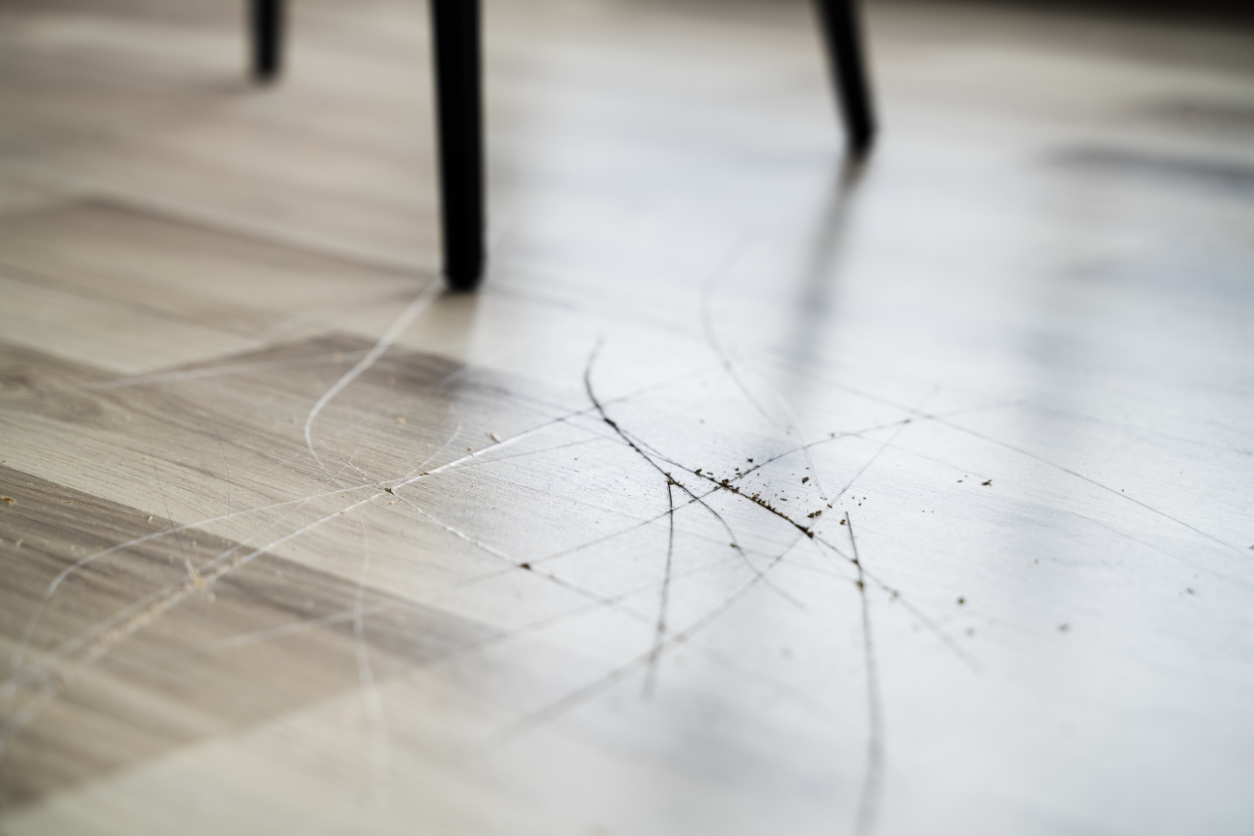Scratches on hardwood floors can be frustrating, especially when you’ve spent time and money to protect and care for your hardwood. But there’s good news: most scratches are fixable. Whether you’ve got a light surface scratch from moving furniture or a deeper gouge that requires more attention, learning how to fix scratches on hardwood floors is key to keeping your space looking pristine. Here’s a guide to addressing everything from minor blemishes to more serious damage.
How to Fix Light Surface Scratches on Hardwood Floors
If you’re dealing with light scratches, you’re in luck because these are typically easier to fix. One method involves simply buffing the scratch out using a hardwood floor cleaner or polish.
- Clean the area: Before doing anything else, make sure the area is clean. Use a microfiber cloth or a soft mop to wipe away dust, dirt, and debris. Cleaning prevents particles from getting trapped in the scratch during the repair process.
- Apply hardwood floor polish: Gently rub a floor polish or repair product over the scratched area. Some polishes are specifically designed to fill in scratches and blend them into the rest of the floor. Buff the surface using a soft cloth, making sure to apply consistent pressure.
- Buff in circular motions: This ensures the polish spreads evenly and fills in the scratch. Let the polish sit for the recommended time on the product label before walking on the area. Once dry, the scratch should be much less noticeable.
How to Fix Deeper Scratches on Hardwood Floors
For deeper scratches, a more hands-on approach is required. You’ll need to fill the scratch and possibly refinish the affected area.
- Sand the scratch: Use fine-grit sandpaper (around 180 to 220 grit) to lightly sand the scratched area. Be careful to only sand the scratch and not the surrounding floor. The goal is to smooth out the rough edges of the scratch without damaging the floor around it.
- Fill the scratch: Once the area is sanded, use a wood filler that matches the color of your hardwood floor. Apply it with a putty knife, ensuring that it fills the entire scratch. Smooth it out with the knife, removing any excess filler. Let it dry completely before moving on to the next step.
- Refinish the area: After the filler has dried, sand the area again using fine-grit sandpaper to ensure it’s level with the rest of the floor. Once smooth, apply a finish that matches your floor. You might need to apply multiple coats, allowing each to dry in between.
Use Furniture Pads to Prevent Future Scratches
One of the best ways to protect your floors from future damage is by using furniture pads (also known as chair leg floor protectors). These small adhesive pads can be attached to the bottom of furniture legs, helping to prevent scratches when furniture is moved. It’s a simple fix that can save your hardwood from future damage.
Blending Deep Scratches with Stain
Sometimes, scratches penetrate deeper into the wood, and simply filling them won’t fully restore the color. In this case, you’ll need to blend the scratch by using a wood stain that matches your floor.
- Apply stain: Use a small brush or cloth to apply a matching wood stain to the scratch. Be sure to only apply the stain to the scratched area to avoid discoloring the surrounding floor.
- Wipe away excess stain: After applying the stain, quickly wipe away any excess with a clean cloth. Let the stain dry completely before assessing the result. You may need to apply a second coat if the first didn’t blend the scratch well enough.
- Seal the scratch: Once the stain is dry, seal the area with a clear finish, such as polyurethane, to protect the repair. This step ensures the scratch blends seamlessly with the rest of the floor and remains protected from future wear.
Preventative Measures for Hardwood Floors
Now that you know how to fix scratches on hardwood floors, it’s worth considering a few preventative measures to reduce the likelihood of future scratches. Here are some ideas:
- Place rugs in high-traffic areas: Entryways, hallways, and living spaces often see the most foot traffic, which can cause wear and tear on hardwood floors. Adding rugs in these areas helps protect the floor from scratches caused by dirt, debris, and shoes.
- Use felt pads on furniture: Attaching felt pads to the bottom of chairs, tables, and other furniture pieces will prevent them from scratching your floors when moved.
- Regular cleaning: A consistent cleaning routine helps prevent scratches by removing dust, grit, and dirt that can grind into the floor. Sweeping or vacuuming a couple of times a week can make a big difference.
- Avoid heels indoors: High-heeled shoes can cause significant damage to hardwood floors. Encourage family members and guests to take off their shoes when entering your home.
Dealing with Scuff Marks
In addition to scratches, hardwood floors are often prone to scuff marks and other minor imperfections. Scuffs can usually be removed with a damp cloth and some mild soap. If the scuff is stubborn, you can use a little baking soda on a damp cloth to gently scrub it away.
For more serious imperfections, a commercial floor cleaner designed for hardwood may do the trick. Regular polishing can also help restore your floor’s shine and smooth out small scratches that don’t penetrate deeply into the wood.

